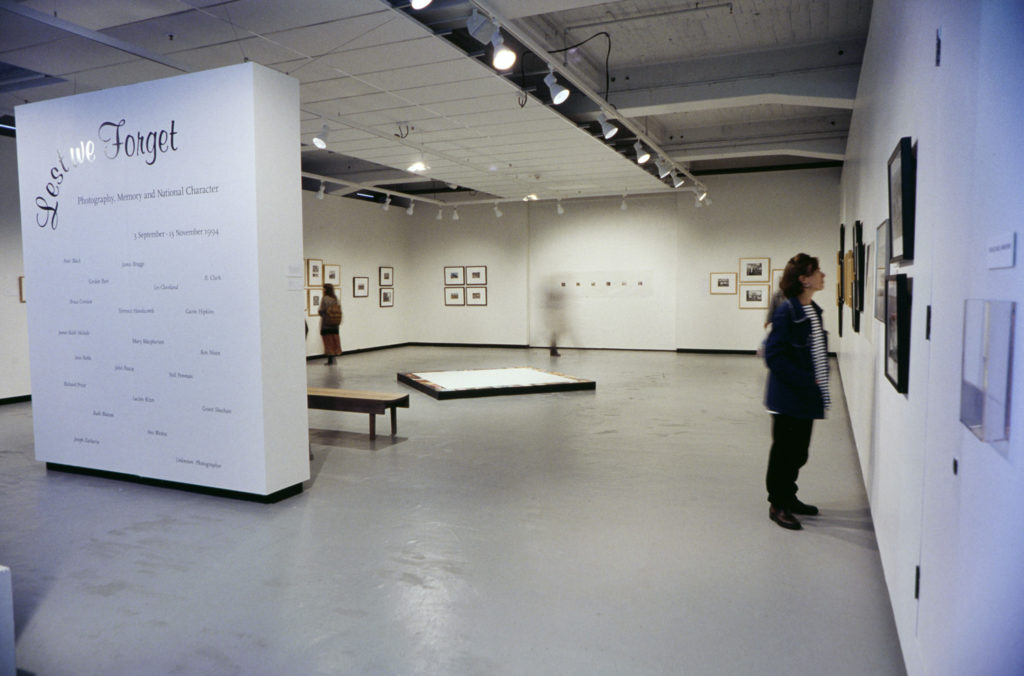ARTISTS Peter Black, James Bragge, Gordon Burt, B. Clark, Les Cleveland, Bruce Connew, Terrence Handscomb, Gavin Hipkins, Mary Macpherson, James Keith Nichols, Ken Niven, Ann Noble, John Pascoe, Neil Penman, Richard Priest, Lucien Rizos, Grant Sheehan, Ruth Watson, Ans Westra, Joseph Zacharia, unknown photographer CURATORS Greg Burke, Deborah Lawler-Dormer PUBLICATION Essay Greg Burke and Deborah Lawler-Dormer
Lest We Forget addresses the relationship between photography and New Zealand identity. It encompasses a broad range of photographic practices (including photojournalism, family snapshots, studio photography, and photomontage; the illustrative and the conceptual) and practitioners (there are names like Ans Westra, Bruce Connew, and Peter Black alongside an anonymous unknown photographer), and with work made over more than 100 years. The show is made to accompany the concurrent national-identity shows Kiwiana and Selling New Zealand.
Curators Gregory Burke and Deborah Lawler-Dormer emphasise photographers who resided in or are associated with Wellington. Their catalogue explains that ‘Wellington’s photographers have always roamed around the country to capture New Zealand on film. As a result Lest We Forget moves between the local and national to explore its themes.’ While Māori and Pasifika people and culture are depicted—for instance, in Neil Penman’s Ramiri Wineera and Her Extended Family (1987), Ann Noble’s Momentos, Pipiriki (1981), and Peter Black’s Samoan Assembly of God Church VII, Berhampore, Wellington (1980)—the photographers are all Pākehā (and only four female).
A colonial mindset is apparent in much of the early work. An unknown photographer documents a family of three standing in front of a barbed-wire fence next to their car, grassy green hills rolling behind them, studded with sheep—the spitting image of a picturesque English countryside. In Ken Niven’s photo of the 1953 royal visit, the streets are lined with people waving, as a procession of cars streams past. A building bears a sign that reads ‘naumai’ with a giant warrior wielding a taiaha. Banners with kowhaiwhai patterns flow down the building. Appropriate dMāori culture gives the colony character.
The earliest photo is James Bragge’s Cnr of Lambton Quay and Customhouse Quay (1877). It shows an intersection just a few blocks away from the Gallery. In the foreground, Victorian men dressed in black stand in front of the stately Bank of New Zealand Building. In the background, a horse and cart can be seen on the wide, muddy road.
The most recent works include Ruth Watson’s Souvenirs du Monde (1994), six colour photos of kitschy souvenirs, displayed behind windows cut from a large sheet of tissue paper. Watson faxes the install instructions from Kunst-Werke Institute for Contemporary Art Berlin, where she's in residence. She apologises for her cramped script; she's trying to keep down the number of pages to mitigate the costs of sending the fax.
Louise Garrett, in her article ‘Mishmash of Ideas about National Identity’, says the show contributes to a ‘1990s mania for retrospection’. It’s an astute observation in the case of Watson, as a version of her work had been shown earlier that year in New York, in an exhibition with almost identical title: Lest We Forget: On Nostalgia.
Writing under a pseudonym, ‘Wiremu' reviews the show in the New Zealand Journal of Photography. He critiques the selection: ‘A hefty proportion of photographs ... could have been easily taken anywhere in the world. The show does have many with kiwi symbols all over the place, some so subtle it would take the Listener crossword expert to decipher them.’ In a toxic footnote, he describes the show as: ‘An exercise in curatorial wanking, this gets the New Zealand Journal of Photography “Dunga Prize” for 1994.’











































